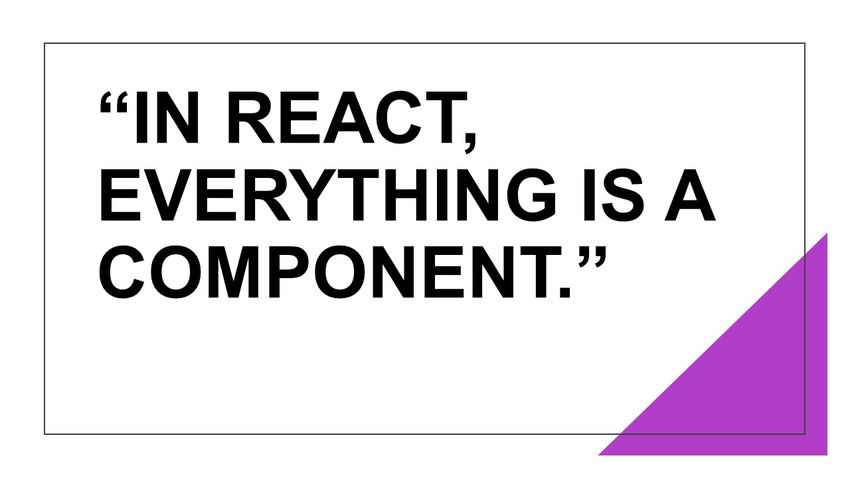“In React, everything is a component” is a fundamental concept that reflects the core architecture and design philosophy of the React library, which is a popular JavaScript library used for building user interfaces. This statement essentially means that the building blocks in a React application are components, and these components can represent various levels of complexity, from small UI elements to entire sections of an application.
Let’s break down the statement in more detail:
- React: React is a JavaScript library developed by Facebook that allows developers to build user interfaces in a declarative and component-based manner. It provides a way to create reusable UI components and manage their dynamic behavior efficiently.
- Everything is a Component:
- Component: A component is a self-contained, reusable piece of code that represents a specific part of a user interface. It encapsulates the HTML, CSS, and JavaScript logic required to render a specific part of a webpage.
- User Interface (UI): In the context of web development, the user interface refers to what users see and interact with on a webpage. This includes buttons, forms, text, images, and more.
- Reusability: One of the key benefits of component-based architecture is reusability. Components can be created once and used multiple times throughout an application. This promotes a modular and maintainable codebase.
- Implications of “Everything is a Component”:
- UI Elements: In React, even simple UI elements like buttons, input fields, headings, and paragraphs are considered components. These are often referred to as “functional” or “presentational” components.
- Complex Sections: Larger parts of the UI, such as navigation bars, sidebars, and entire pages, can also be represented as components. These are often referred to as “container” or “structural” components.
- Hierarchy: Components can be nested within each other, forming a hierarchical structure. This allows developers to build complex UIs by composing smaller components into larger ones.
- Data Flow: Components can communicate with each other through a unidirectional data flow. Data can be passed from parent components to child components through “props” (short for properties). This enables the building of dynamic and interactive UIs.
- State Management: React components can also manage their internal state using the “state” mechanism. This allows components to handle dynamic behavior and respond to user interactions.
- Lifecycle Methods: Components have lifecycle methods that provide hooks for developers to perform actions at different stages of a component’s existence, such as when it is created, updated, or unmounted.
In short, the phrase “In React, everything is a component” underscores the importance of components as the building blocks of a React application. It emphasizes the modular, reusable, and organized nature of React development, which contributes to more efficient, maintainable, and scalable code.
The component-centric approach has several implications for building applications:
- Reusability: Components can be created once and reused throughout the application, promoting a modular and efficient codebase. This helps in maintaining a consistent UI and behavior.
- Hierarchy: Components can be nested within each other, forming a hierarchy that represents the UI’s structure. This allows us to compose complex UIs by combining smaller components.
- Data Flow: Components communicate with each other through a unidirectional data flow. Data can be passed from parent to child components using props, allowing dynamic interactions.
- State Management: Components can manage their internal state using the ‘state’ mechanism. This enables components to handle dynamic behavior and respond to user actions without needing external management.
- Lifecycle Methods: Components have lifecycle methods that provide hooks for performing actions at various stages of a component’s lifecycle, such as mounting, updating, and unmounting.
By adhering to the “everything is a component” principle, React promotes a modular, maintainable, and scalable approach to building user interfaces. This philosophy aligns with the reusability and organization of code, making development more efficient and collaborative.”
How to answer when asked in the interview
This is the most popular interview question asked, when asked about the concept “In React, everything is a component” In a job interview, you can provide a detailed and concise explanation that demonstrates your understanding of the concept and its implications. Here’s a suggested response:
In React, the principle ‘everything is a component’ underscores the modular nature of the framework. A component is a self-contained unit responsible for rendering a specific part of the UI. This concept enhances reusability, promotes a structured UI hierarchy, and allows effective communication between components. Whether it’s a simple button or a complex form, the component-centric approach simplifies development, fosters maintainability, and supports a seamless user experience.”
![]()




